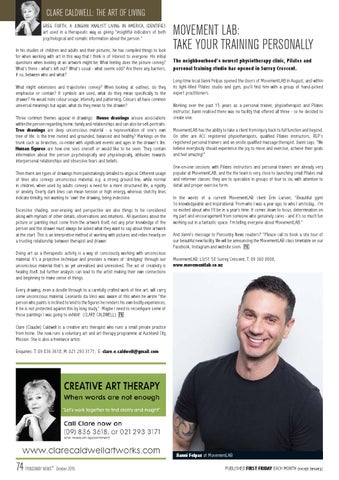CLARE CALDWELL: THE ART OF LIVING GREG FURTH, A JUNGIAN ANALYST LIVING IN AMERICA, IDENTIFIES art used in a therapeutic way as giving “insightful indicators of both psychological and somatic information about the person.” In his studies of children and adults and their pictures, he has compiled things to look for when working with art in this way that I think is of interest to everyone. His initial questions when looking at an artwork might be: What feeling does the picture convey? What’s there - what’s left out? What’s usual - what seems odd? Are there any barriers, if so, between who and what? What might extensions and trajectories convey? When looking at outlines, do they emphasise or contain? If symbols are used, what do they mean specifically to the drawer? He would note colour usage, intensity and patterning. Colours all have common universal meanings but again, what do they mean to the drawer? Three common themes appear in drawings: House drawings arouse associations within the person regarding home, family and relationships and can also be self-portraits. Tree drawings are deep unconscious material - a representation of one’s own tree of life. Is the tree rooted and grounded, balanced and healthy? Markings on the trunk such as branches, co-relate with significant events and ages in the drawer’s life. Human figures are how one sees oneself or would like to be seen. They contain information about the person psychologically and physiologically, attitudes towards interpersonal relationships and obsessive fears and beliefs. Then there are types of drawings from painstakingly detailed to atypical. Different usage of lines also conveys unconscious material, e.g. a strong ground line, while normal in children, when used by adults conveys a need for a more structured life, a rigidity or anxiety. Overly dark lines can mean tension or high energy, whereas sketchy lines indicate timidity, not wanting to ‘own’ the drawing, being indecisive. Excessive shading, over-erasing and perspective are also things to be considered along with myriads of other details, observations and intuitions. All questions about the picture or painting must come from the artwork itself, not any prior knowledge of the person and the drawer must always be asked what they want to say about their artwork at the start. This is an interpretive method of working with pictures and relies heavily on a trusting relationship between therapist and drawer. Doing art as a therapeutic activity is a way of consciously working with unconscious material. It’s a projective technique and provides a means of ‘dredging’ through our unconscious material that’s as yet unrealised and unresolved. The act of creativity is healing itself, but further analysis can lead to the artist making their own connections and beginning to make sense of things.
MOVEMENT LAB: TAKE YOUR TRAINING PERSONALLY The neighbourhood’s newest physiotherapy clinic, Pilates and personal training studio has opened in Surrey Crescent. Long-time local Jianni Felpas opened the doors of MovementLAB in August, and within its light-filled Pilates studio and gym, you’ll find him with a group of hand-picked expert practitioners. Working over the past 15 years as a personal trainer, physiotherapist and Pilates instructor, Jianni realised there was no facility that offered all three - so he decided to create one. MovementLAB has the ability to take a client from injury back to full function and beyond. On offer are ACC registered physiotherapists, qualified Pilates instructors, REP’s registered personal trainers and an onsite qualified massage therapist. Jianni says, “We believe everybody should experience the joy to move and exercise, achieve their goals and feel amazing!” One-on-one sessions with Pilates instructors and personal trainers are already very popular at MovementLAB, and the the team is very close to launching small Pilates mat and reformer classes: they are to specialise in groups of four to six, with attention to detail and proper exercise form. In the words of a current MovementLAB client Erin Larsen; “Beautiful gym! So knowledgeable and inspirational. From who I was a year ago, to who I am today... I’m so excited about who I’ll be in a year’s time. It comes down to focus, determination on my part and encouragement from someone who genuinely cares - and it’s so much fun working out in a fantastic space. I’m telling everyone about MovementLAB.” And Jianni’s message to Ponsonby News readers? “Please call to book a site tour of our beautiful new facility. We will be announcing the MovementLAB class timetable on our Facebook, Instagram and website soon. F PN MovementLAB, L3/S1 58 Surrey Crescent, T: 09 360 0008, www.movementlab.co.nz
Every drawing, even a doodle through to a carefully crafted work of fine art, will carry some unconscious material. Leonardo da Vinci was aware of this when he wrote “the person who paints is inclined to lend to the figures he renders his own bodily experiences, if he is not protected against this by long study.” Maybe I need to reconfigure some of those paintings I was going to exhibit! (CLARE CALDWELL) F PN Clare (Claudie) Caldwell is a creative arts therapist who runs a small private practice from home. She now runs a voluntary art and art therapy programme at Auckland City Mission. She is also a freelance artist. Enquiries: T: 09 836 3618; M: 021 293 3171; E: clare.e.caldwell@gmail.com
Jianni Felpas of MovementLAB
74 PONSONBY NEWS+ October 2015
PUBLISHED FIRST FRIDAY EACH MONTH (except January)
